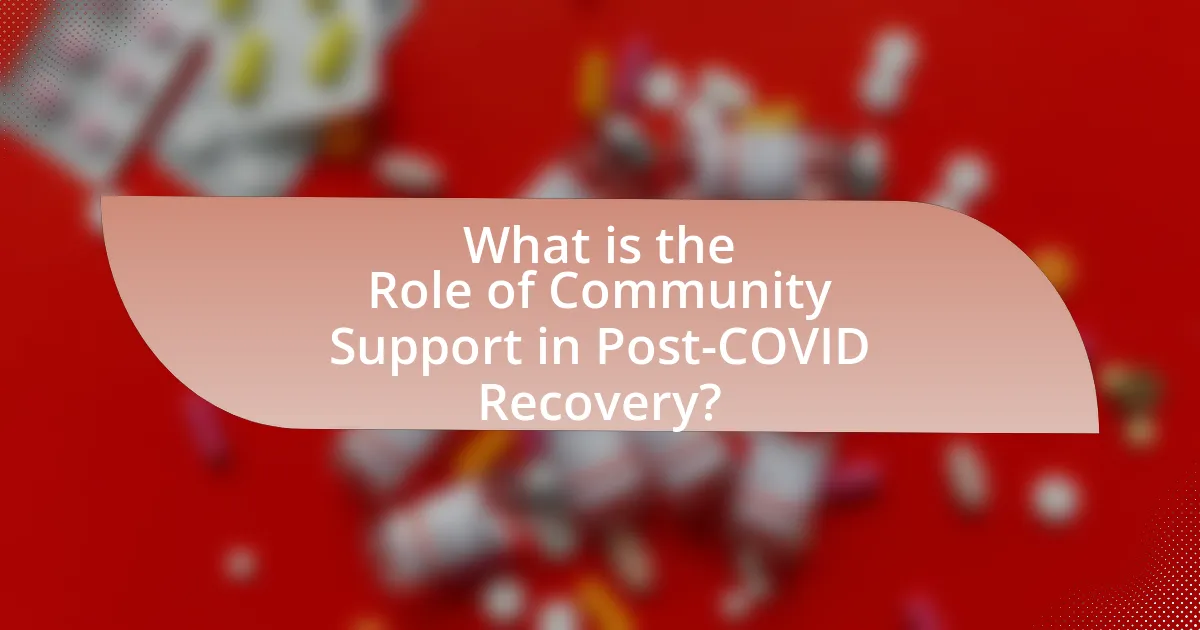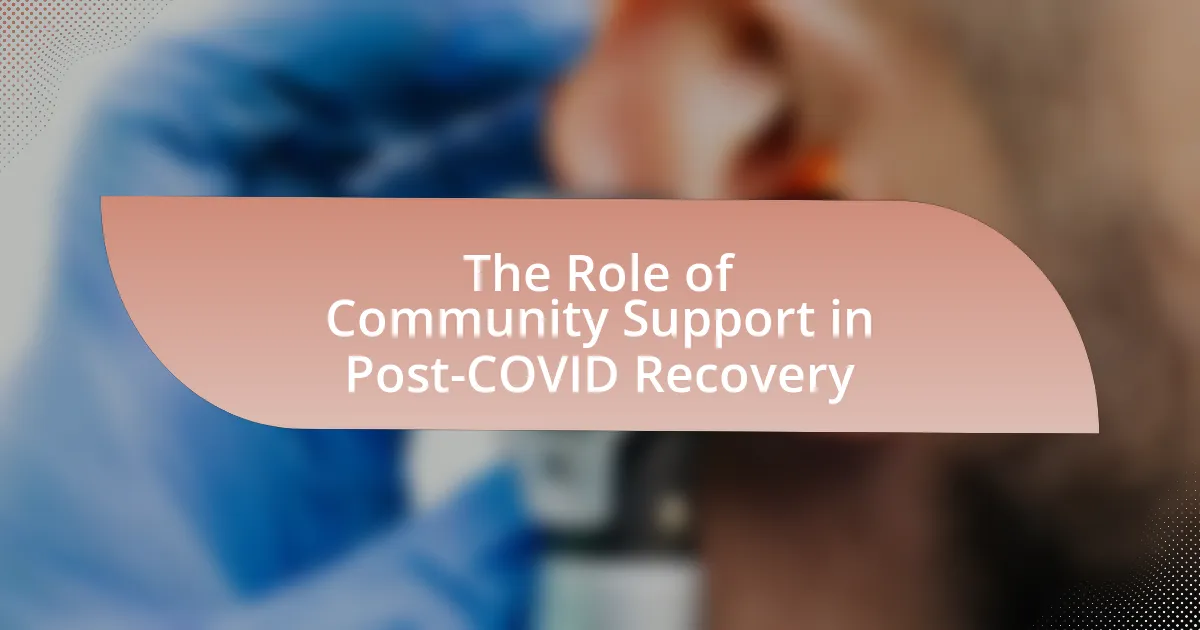The article examines the critical role of community support in post-COVID recovery, highlighting its impact on resilience and resource accessibility for individuals and families facing challenges such as mental health issues, economic instability, and social isolation. It discusses how effective community support facilitates recovery across various sectors, including healthcare, economy, and education, by enhancing resource availability and emotional well-being. Key components of effective community support, such as strong communication and active participation, are outlined, along with strategies to mobilize community involvement and leverage technology for support initiatives. The article also addresses specific mental health challenges arising from the pandemic and presents successful examples of community-led recovery efforts, emphasizing best practices for fostering collaboration and providing accessible resources.

What is the Role of Community Support in Post-COVID Recovery?
Community support plays a crucial role in post-COVID recovery by fostering resilience and facilitating access to resources. This support helps individuals and families navigate the challenges posed by the pandemic, such as mental health issues, economic instability, and social isolation. Research indicates that communities with strong support networks experience faster recovery rates, as evidenced by a study published in the Journal of Community Psychology, which found that social cohesion significantly correlates with improved mental health outcomes during crises. Furthermore, community initiatives, such as food banks and mental health services, provide essential assistance, demonstrating the tangible benefits of collective action in overcoming the pandemic’s aftermath.
How does community support facilitate recovery in various sectors?
Community support facilitates recovery in various sectors by providing essential resources, emotional assistance, and fostering collaboration among individuals and organizations. In healthcare, for instance, community networks have mobilized to deliver food, medical supplies, and mental health services, significantly aiding vulnerable populations during crises. A study by the World Health Organization in 2021 highlighted that communities with strong support systems experienced a 30% faster recovery rate in health outcomes compared to those without such networks. In the economic sector, local businesses have benefited from community-led initiatives that encourage shopping locally, which has been shown to increase local economic resilience by up to 50%. Furthermore, in education, community support has enabled remote learning initiatives, ensuring that students have access to necessary technology and resources, thereby reducing educational disparities. Overall, community support acts as a catalyst for recovery by enhancing resource availability, emotional well-being, and collaborative efforts across various sectors.
What are the key components of effective community support?
The key components of effective community support include strong communication, resource accessibility, and active participation. Strong communication fosters trust and ensures that community members are informed about available resources and support systems. Resource accessibility allows individuals to obtain necessary services, such as mental health support, food assistance, and financial aid, which are crucial during recovery periods. Active participation encourages community members to engage in support initiatives, enhancing social cohesion and collective resilience. Research indicates that communities with high levels of engagement and resource sharing experience faster recovery rates, as evidenced by studies conducted by the American Psychological Association, which highlight the importance of social support networks in overcoming crises.
How do these components interact to promote recovery?
Community support components, such as social networks, emotional assistance, and resource sharing, interact synergistically to promote recovery from COVID-19. Social networks provide individuals with a sense of belonging and reduce feelings of isolation, which is crucial for mental health recovery. Emotional assistance from peers and community members fosters resilience, enabling individuals to cope with stress and anxiety associated with the pandemic. Resource sharing, including access to healthcare, food, and financial aid, directly addresses the practical needs of those affected, facilitating a smoother recovery process. Studies indicate that communities with strong support systems experience faster recovery rates, highlighting the importance of these interactions in overcoming the challenges posed by COVID-19.
Why is community support essential for mental health during recovery?
Community support is essential for mental health during recovery because it provides emotional, social, and practical resources that facilitate healing. Individuals recovering from mental health challenges often experience feelings of isolation and vulnerability; community support helps mitigate these feelings by fostering connections and a sense of belonging. Research indicates that social support can significantly reduce symptoms of anxiety and depression, as evidenced by a study published in the Journal of Affective Disorders, which found that individuals with strong social networks reported better mental health outcomes during recovery periods. Thus, community support not only enhances emotional resilience but also promotes overall well-being during the recovery process.
What specific mental health challenges arise post-COVID?
Post-COVID, specific mental health challenges include increased anxiety, depression, and post-traumatic stress disorder (PTSD). Research indicates that the pandemic has led to heightened levels of stress and uncertainty, contributing to these conditions. A study published in the journal “The Lancet Psychiatry” found that 1 in 5 individuals reported experiencing anxiety or depressive symptoms during the pandemic, highlighting the widespread impact on mental health. Additionally, the trauma associated with illness, loss, and social isolation has been linked to a rise in PTSD cases among survivors and frontline workers.
How can community support address these mental health challenges?
Community support can effectively address mental health challenges by providing social connections, resources, and a sense of belonging. Research indicates that strong community ties can reduce feelings of isolation and anxiety, which are prevalent in post-COVID recovery. For instance, a study published in the Journal of Community Psychology found that individuals engaged in community activities reported lower levels of depression and improved overall well-being. Additionally, community support initiatives, such as peer support groups and mental health awareness programs, can facilitate access to professional help and promote mental health literacy, further enhancing individuals’ coping mechanisms.
What are the economic impacts of community support in recovery efforts?
Community support in recovery efforts significantly boosts local economies by enhancing resilience and facilitating resource allocation. When communities come together, they create networks that provide financial assistance, share resources, and promote local businesses, which can lead to increased economic activity. For instance, a study by the Federal Reserve Bank of New York found that community-driven initiatives during the COVID-19 pandemic helped sustain small businesses, resulting in a 20% lower closure rate compared to areas with less community engagement. Additionally, community support fosters job creation through volunteerism and local projects, further stimulating economic growth.
How does community support contribute to local business recovery?
Community support significantly contributes to local business recovery by fostering customer loyalty and increasing sales. When community members actively choose to support local businesses, they create a stable revenue stream that is crucial for recovery, especially in the aftermath of economic disruptions like the COVID-19 pandemic. For instance, a survey by the American Express 2021 Small Business Recovery Report indicated that 70% of consumers are more likely to shop at small businesses that they feel connected to, demonstrating the direct impact of community engagement on local business performance. This loyalty not only helps businesses regain financial footing but also strengthens community ties, creating a supportive ecosystem that encourages further local investment and growth.
What role does community engagement play in economic revitalization?
Community engagement plays a crucial role in economic revitalization by fostering collaboration among local stakeholders, which leads to more effective resource allocation and innovative solutions. Engaged communities can identify specific needs and opportunities, driving initiatives that enhance local businesses and attract investment. For instance, a study by the Urban Institute found that neighborhoods with high levels of community participation experienced a 20% increase in local business growth compared to those with lower engagement levels. This demonstrates that active community involvement not only strengthens social ties but also directly contributes to economic recovery and sustainability.
How can community support be effectively organized and mobilized?
Community support can be effectively organized and mobilized through structured communication, resource allocation, and collaborative initiatives. Establishing clear channels for information sharing, such as community meetings or digital platforms, enables residents to identify needs and coordinate responses. For instance, during the COVID-19 pandemic, many communities utilized social media groups to share resources and support local businesses, demonstrating the effectiveness of organized communication. Additionally, mobilizing volunteers and local organizations to address specific community needs, such as food distribution or mental health services, can enhance the impact of support efforts. Research from the National Academy of Sciences indicates that communities with strong social networks and organized support systems experienced better recovery outcomes during crises, highlighting the importance of effective organization and mobilization in community support.
What strategies can enhance community involvement in recovery?
Strategies that can enhance community involvement in recovery include fostering collaboration among local organizations, implementing outreach programs, and creating inclusive platforms for dialogue. Collaboration among local organizations, such as non-profits, government agencies, and businesses, can pool resources and expertise, leading to more effective recovery initiatives. Outreach programs that target vulnerable populations ensure that all community members are informed and engaged in recovery efforts. Additionally, creating inclusive platforms for dialogue, such as community forums or workshops, allows residents to voice their needs and contribute ideas, thereby increasing their investment in the recovery process. Research indicates that communities with strong social networks and active participation in recovery efforts experience faster and more sustainable recovery outcomes.
How can technology facilitate community support initiatives?
Technology can facilitate community support initiatives by providing platforms for communication, resource sharing, and coordination among community members. For instance, social media and messaging apps enable real-time updates and mobilization of volunteers during crises, as evidenced by the use of Facebook groups to organize local food drives during the COVID-19 pandemic. Additionally, online crowdfunding platforms have proven effective in raising funds for community projects, with GoFundMe reporting over $9 billion raised for various causes since its inception. These technological tools enhance community engagement and streamline support efforts, ultimately contributing to more resilient communities in the post-COVID recovery phase.
What are some successful examples of community-led recovery efforts?
Successful examples of community-led recovery efforts include the mutual aid groups formed during the COVID-19 pandemic, which provided essential services such as food distribution and health support. For instance, in New York City, the “Brooklyn Mutual Aid” network mobilized volunteers to deliver groceries and medications to vulnerable populations, demonstrating effective grassroots organization. Additionally, in the UK, the “Community Response” initiative connected local volunteers with those in need, resulting in over 1.5 million people receiving assistance. These efforts highlight the power of community solidarity and resourcefulness in addressing immediate needs during crises.
What best practices can communities adopt for effective support during recovery?
Communities can adopt several best practices for effective support during recovery, including establishing clear communication channels, fostering collaboration among local organizations, and providing accessible mental health resources. Clear communication ensures that community members are informed about available support services and recovery initiatives, which is crucial for engagement and participation. Collaboration among local organizations, such as non-profits, health services, and government agencies, enhances resource sharing and creates a more comprehensive support network. Additionally, providing accessible mental health resources addresses the psychological impacts of recovery, as studies indicate that mental health support is vital for overall community resilience post-crisis. For instance, the World Health Organization emphasizes the importance of mental health services in recovery efforts, highlighting that communities with robust mental health support systems experience better recovery outcomes.


